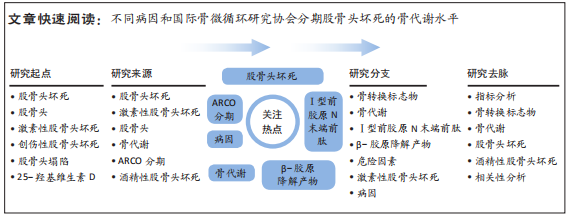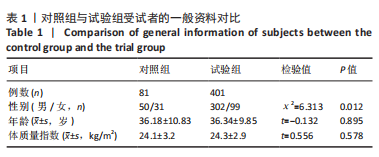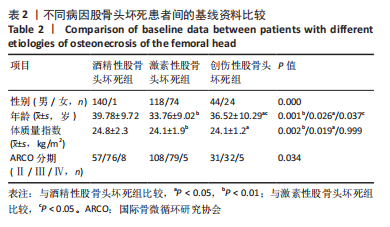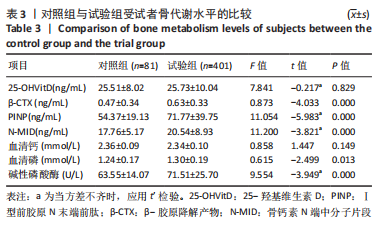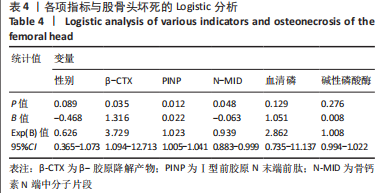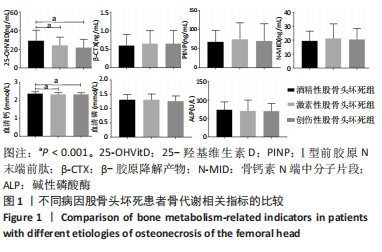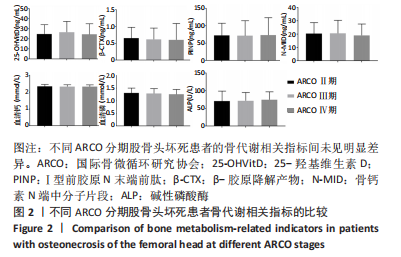[1] MONT MA, SALEM HS, PIUZZI NS, et al. Nontraumatic Osteonecrosis of the Femoral Head: Where Do We Stand Today: A 5-Year Update. J Bone Joint Surg Am. 2020;102(12):1084-1099.
[2] CUI L, ZHUANG Q, LIN J, et al. Multicentric epidemiologic study on six thousand three hundred and ninety five cases of femoral head osteonecrosis in China. Int Orthop. 2016;40(2):267-276.
[3] 何伟. 如何把握股骨头坏死患者的保髋治疗时机[J]. 中国骨与关节杂志,2016,5(2):82-86.
[4] SHI Z, JIN H, DING Q, et al. Bone turnover markers may predict the progression of osteonecrosis of the femoral head in aged males. Ann Transl Med. 2019;7(22):626.
[5] ARAI R, TAKAHASHI D, INOUE M, et al. Efficacy of teriparatide in the treatment of nontraumatic osteonecrosis of the femoral head: a retrospective comparative study with alendronate. BMC Musculoskelet Disord. 2017;18(1):24.
[6] HERNIGOU P, FLOUZAT-LACHANIETTE CH, DELAMBRE J, et al. Osteonecrosis repair with bone marrow cell therapies: state of the clinical art. Bone. 2015;70:102-109.
[7] YOON BH, MONT MA, KOO KH, et al. The 2019 Revised Version of Association Research Circulation Osseous Staging System of Osteonecrosis of the Femoral Head. J Arthroplasty. 2020;35(4): 933-940.
[8] 中国医师协会骨科医师分会骨循环与骨坏死专业委员会,中华医学会骨科分会骨显微修复学组,国际骨循环学会中国区 .中国成人股骨头坏死临床诊疗指南(2020)[J]. 中华骨科杂志,2020,40(20): 1365-1376.
[9] GOLOB AL, LAYA MB. Osteoporosis: screening, prevention, and management. Med Clin North Am. 2015;99(3):587-606.
[10] XIAO W, WANG Y, PACIOS S, et al. Cellular and Molecular Aspects of Bone Remodeling. Front Oral Biol. 2016;18:9-16.
[11] GLENDENNING P, CHUBB S, VASIKARAN S. Clinical utility of bone turnover markers in the management of common metabolic bone diseases in adults. Clin Chim Acta. 2018;481:161-170.
[12] FANG S, LI Y, CHEN P. Osteogenic effect of bone marrow mesenchymal stem cell-derived exosomes on steroid-induced osteonecrosis of the femoral head. Drug Des Devel Ther. 2019;13:45-55.
[13] MUTIJIMA E, DE MAERTELAER V, DEPREZ M, et al. The apoptosis of osteoblasts and osteocytes in femoral head osteonecrosis: its specificity and its distribution. Clin Rheumatol. 2014;33(12):1791-1795.
[14] 张萌萌,毛未贤,高远,等. ON、PINP、OPG、IGF-1、TGF-β与股骨颈BMD相关性研究[J]. 中国骨质疏松杂志,2014,20(8):880-884.
[15] 董松格. 激素性股骨头坏死患者血清PINP、CTX、OST的变化及意义[D]. 泰安:泰山医学院,2013.
[16] HAN L, WANG B, WANG R, et al. The shift in the balance between osteoblastogenesis and adipogenesis of mesenchymal stem cells mediated by glucocorticoid receptor. Stem Cell Res Ther. 2019; 10(1):377.
[17] 魏秋实,杨帆,陈哓俊,等. 激素性与酒精性股骨头坏死患者骨标本坏死区域病理与显微结构特点分析[J]. 中国修复重建外科杂志, 2018,32(7):866-872.
[18] 刘军川,薛庆云,文良元,等. 老年髋部骨质疏松性骨折患者早期骨代谢的前瞻性研究[J]. 中国骨与关节杂志,2018,7(3):163-167.
[19] 许昊,李毅中,庄华烽,等. 血清25羟维生素D水平与脆性髋部骨折关系的研究[J]. 中国骨质疏松杂志,2020,26(3):340-344.
[20] CHEN XT, ZHU YJ, LIU YW, et al. Metal trabecular bone reconstruction system better improves clinical efficacy and biomechanical repair of osteonecrosis of the femoral head than free vascularized fibular graft: A case-control study. J Cell Physiol. 2019;234(11):20957-20968.
[21] 付强,郑宝森. 早期股骨头缺血性坏死患者脂联素、CRP、TNF-α及NO水平与骨髓水肿和疼痛分级的相关性研究[J]. 中国实验诊断学,2015,19(10):1783-1785.
[22] ZHAO H, YEERSHENG R, XIA Y, et al. Hypoxia Enhanced Bone Regeneration Through the HIF-1alpha/beta-Catenin Pathway in Femoral Head Osteonecrosis. Am J Med Sci. 2021;362(1):78-91.
[23] LEE YK, HA YC, CHO YJ, et al. Does Zoledronate Prevent Femoral Head Collapse from Osteonecrosis? A Prospective, Randomized, Open-Label, Multicenter Study. J Bone Joint Surg Am. 2015;97(14):1142-1148.
[24] LEBOFF MS, GREENSPAN SL, INSOGNA KL, et al. The clinician’s guide to prevention and treatment of osteoporosis. Osteoporos Int. 2022;33(10):2049-2102.
[25] CHEVALLEY T, BRANDI ML, CASHMAN KD, et al. Role of vitamin D supplementation in the management of musculoskeletal diseases:update from an European Society of Clinical and Economical Aspects of Osteoporosis, Osteoarthritis and Musculoskeletal Diseases (ESCEO) working group. Aging Clin Exp Res. 2022;34(11):2603-2623.
[26] 尧光学. 维生素D与激素性股骨头坏死骨代谢相关性初步探究[D]. 广州:广州中医药大学,2016.
[27] TIAN L, BAEK SH, JANG J, et al. Imbalanced bone turnover markers and low bone mineral density in patients with osteonecrosis of the femoral head. Int Orthop. 2018;42(7):1545-1549.
[28] KAMAL KC, ALEXANDRU DO, ROGOVEANU OC, et al. Immunohistochemical analysis of bone metabolism in osteonecrosis of the femoral head. Rom J Morphol Embryol. 2018;59(3):819-824.
[29] CRIM J, LAYFIELD LJ, STENSBY JD, et al. Comparison of Radiographic and Pathologic Diagnosis of Osteonecrosis of the Femoral Head. AJR Am J Roentgenol. 2021;216(4):1014-1021.
[30] WANG P, WANG C, MENG H, et al. The Role of Structural Deterioration and Biomechanical Changes of the Necrotic Lesion in Collapse Mechanism of Osteonecrosis of the Femoral Head. Orthop Surg. 2022; 14(5):831-839. |
